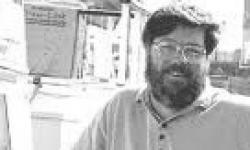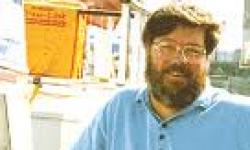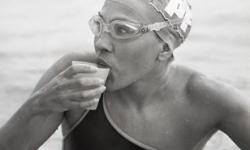27 Jul 2013Adriano Passini swims the Channel

Adriano swam the Channel in 11 hours and 10 minutes; accompanied by EC legend Karteek Clarke
Story by Adriano Passini (32), aviation engineer from Sao Paulo, Brazil, who swam the English Channel on a spring tide on July 27th, 2013, in 11 hours 10 min.
July 27th of 2013 was a great day, probably one of the best days of my life. Conquering the “Mount Everest” of the swimming world is something unbelievable for a person who some years ago would never even think of running a marathon. In addition, 2 years before my successful swim of the English Channel, I had never swum more than 4 km in the sea.
How was it possible? How did I conquer all the difficulties? What made this dream a reality? Eight years ago I started to study meditation under my teacher Sri Chinmoy and started to be part of the most successful team in the English Channel, the Sri Chinmoy Marathon Team. This fact changed my life, because I developed the capacity to bring forward some qualities that are necessary not only to swim the English Channel, but also to be a better person.
This process made me more disciplined, determined, patient and even more eager for self-transcendence. Two years ago I got the inspiration to swim the English Channel, inspired by an aphorism of Sri Chinmoy: “We all truly unlimited, if we only dare to try and have faith.” I dived deep in this challenge.
Training for the English Channel is not easy, but it is not impossible. I had to face a number of challenges, for example, working all day long as an engineer and going to the pool at night to swim in cold water, not having enough time for training,plus cold showers every day even in the winter. Long distance training on the weekends and fighting against the mind in the last weeks before my attempt of the English Channel. The last weeks of training are not an easy task. Keeping the discipline was the hardest part in this challenge.
The days before my attempt were amazing. Staying in Dover is somethingvery special. When the swimmer feels the English Channel, the cold water, everything, he just wants to jump into the water and reach France. When the greatday comes, I just wanted to remember all the dificulties that I had to transcend, all the efforts involved.
The moment I started my swim I put together all the pieces of discipline and determination that I had collected over the last two years and I had just one thought in my mind: “I will never give up, never! I will swim until France right now with all my determination!”
I had a very good crew, my pilot was Chris Osmond, a very experienced English Channel pilot. My helpers were Ashirvad Zaiantchick, a friend of mine from Brazil, and my teammate Karteek Clarke from Edinburgh, one of the most experienced English Channel swimmers who has already swum the Channel 10 times.
During my attempt there were a number of challenges. For example, I started swimming at 2:30 a.m. at night. In the first 5 hours it rained a lot, with a very intense fog, I was caught by some jellyfish, there was even lightning, it was cold outside the water and a huge ship almost collided with our boat in the fog. The water temperature was 16°C, and I had to keep a good cadence of strokes per minute to keep my body warm.
In addition, I swam on a spring tide, which pushed me quite some distance to the north and took me back to the south. We decided to swim on the spring tide because there was no wind in the channel (as is so often the case, swimmers had been waiting for days for the weather to be swimmable and there were a few more boats out that night). After 11 hours and 10 minutes I landed in France at Wissant Bay with a lot of joy and the feeling that I completed my mission. Even the sun came out at the end!
These were some of the physical difficulties, but to fight against the mind is more important than this. The swimmer has to develop the capacity to keep the mind calm during the crossing, which can be done with proper training - through meditation and long distance trainings, where the swimmer starts to become more confident. I really recommend that swimmers who want to swim the English Channel develop a calm mind for swimming and remain confident from the time they register for the English Channel until the moment they reach the French coast.
Swimming the English Channel is not easy, it is very hard, but every person with the eagerness for self-transcendence and the determination to face all the difficulties for sure can cross the English Channel. All the swimmers have their own stories, but all of them are similar in one respect. They feel: “Nothing is impossible with determination”.
More about his swim and his preparation in this video-interview: http://vimeo.com/71583193
PS: Adriano's swim is the 44th non-wetsuit solo swim of the English Channel by a member of the International Sri Chinmoy Marathon Team, whose founder, Sri Chinmoy, was inducted as an honour administrator into the International Marathon Swimming Hall of Fame in 2013. One day after his swim, Adriano joined the dedication of a Sri Chinmoy Peace Statue in Ipswich – he had actually concentrated on being able to swim by the 27th to make it to Ipswhich on the 28th.
More details on:
http://www.channel-triathlon.com/2013/08/07/adriano-passini-from-brazil-our-teams-new-english-channel-swimmer/
http://www.karteekclarke.com/open-water-swims/determination-wins-the-dayadriano-completes-channel-swim-in-11-hours-and-10-minutes/#more-510
Sandettie Lightship Observations
2am, 4th December 2025
Water: 53.2 °F (11.8 °C)
Air: 45.7 °F (7.6 °C)
Wind Speed: 20.0 kn (37.0 km/h)
Wind Direction: SSE (160°)
The CS&PF President, Mike Ball and all the committee are deeply saddened by the passing of Ady Brown.… https://t.co/E17pLxZwgw
3 years ago












